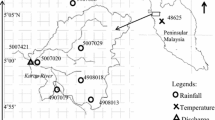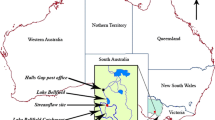Abstract
Linear and non-linear statistical ‘downscaling’ study is applied to relate large-scale climate information from a general circulation model (GCM) to local-scale river flows in west Iran. This study aims to investigate and evaluate the more promising downscaling techniques, and provides a through inter comparison study using Karkheh catchment as an experimental site in a semi arid region for the years of 2040 to 2069. A hybrid conceptual hydrological model was used in conjunction with modeled outcomes from a General Circulation Model (GCM), HadCM3, along with two downscaling techniques, Statistical Downscaling Model (SDSM) and Artificial Neural Network (ANN), to determine how future streamflow may change in a semi arid catchment. The results show that the choice of a downscaling algorithm having a significant impact on the streamflow estimations for a semi-arid catchment, which are mainly, influenced, respectively, by atmospheric precipitation and temperature projections. According to the SDSM and ANN projections, daily temperature will increase up to +0.58 0C (+3.90 %) and +0.48 0C (+3.48 %), and daily precipitation will decrease up to −0.1 mm (−2.56 %) and −0.4 mm (−2.82 %) respectively. Moreover streamflow changes corresponding to downscaled future projections presented a reduction in mean annual flow of −3.7 m^3/s and −9.47 m^3/s using SDSM and ANN outputs respectively. The results suggest a significant reduction of streamflow in both downscaling projections, particularly in winter. The discussion considers the performance of each statistical method for downscaling future flow at catchment scale as well as the relationship between atmospheric processes and flow variability and changes.











Similar content being viewed by others
References
Alfsen K, Barrow EB et al (2007) General guidelines on the use of scenario data for climate impact and adaptation assessment. Cambridge University Press, UK, pp 11–19
Cannon AJ, Whitfield PH (2002) Downscaling recent streamflow conditions in British Columbia, Canada using ensemble neural network models. J Hydrol 259:136–151
Croke BFW, Smith AB, Jakeman AJ (2002) A One-Parameter Groundwater Discharge Model Linked to the IHACRES -Runoff Model. 1st Biennial Meeting of the International Environmental Modeling and Software Society, University of Lugano, Switzerland 428–433
Dibike YB, Coulibaly P (2006) Temporal neural networks for downscaling climate variability and extremes. Neural Netw 19:135–144
Ghosh S, Katkar S (2012) Modeling uncertainty resulting from multiple downscaling methods in assessing hydrological impacts of climate change. Water Resour Manag 26:3559–3579
Ghosh S, Mujumdar PP (2008) Statistical downscaling of GCM simulations to streamflow using relevance vector machine. Adv Water Resour 31:132–146
Habets F, Boone A et al (2008) The SAFRAN-ISBA-MODCOU hydrometeorological model applied over France. J Geophys Res 113:D06113
Jakeman AJ, Hornberger GM (1993a) How much complexity is warranted in a -runoff model? Water Resour Res 8:2637–2649
Jakeman AJ, Hornberger GM (1993b) Hydrological extremes in a southwestern Ontario river basin under future climate conditions. Hydrolog Sci J 4:631–654
Kokkonen T, Jakeman AJ, Young PC, Koivusalo HJ (2003) predicting daily flows in ungauged catchments: model regionalization from catchment descriptors at the Coweeta Hydrologic Laboratory, North Carolina. Hydrol Process 11:2219–2238
Landman WA, Mason SJ, Tyson PD, Tennant WJ (2001) Statistical downscaling of GCM simulations to streamflow. J Hydrol 252:221–236
Linz H, Shiklomanov I, Mostefakara K (1990) Chapter 4, Hydrology and water. In: Likely impact of climate change. IPCC WGII report, WMO/UNEP, Geneva
MacDonald RJ, Byrne JM, Boon S, Kienzle SW (2012) Modelling the Potential Impacts of Climate Change on Snowpack in the North Saskatchewan River Watershed, Alberta. Water Resour Manag 26:3053–3076
Moradkhani H, Meier M (2010) Long-lead water supply forecast using large-scale climate predictors and independent component analysis. J Hydrol Eng 15:744–762
Nash JE, Sutcliffe JV (1970) River flow forecasting through conceptual models, Part-1: a discussion of principles. J Hydrol 3:282–290
Post DA, Jakeman AJ (1996) Relationships between catchment attributes and hydrological response characteristics in small Australian mountain ash catchments. Hydrol Process 6:877–892
Samadi SZ, Mahdavi M, Sharifi F, Bihamta MR (2009) Methodology for selecting the best predictor for climate change impact assessment in Karkheh Basin, Iran. J Environ Eng Sci 4:249–256
Samadi SZ, Sagareswar G, Tajiki M (2010) Comparison of general circulation models: methodology for selecting the best GCM in Kermanshah Synoptic Station, Iran. Int J Glob Warm 4:347–365
Semenov MA (2007) Developing of high-resolution UKCUP02-based climate change scenarios in the UK. Agric Forest Meteorol 2:127–138
Thompson JR, Refstrup Sørenson H, Gavina H, Refsgaard A (2004) Application of the coupled MIKE SHE/MIKE 11 modelling system to a lowland wet grassland in southeast England. J Hydrol 293:151–179
Wilby RL, Hassan H, Hanaki (1997) Statistical downscaling of hydro meteorological variables using general circulation model output. J Hydrol 205:1–19
Wilby RL, Tomlinson OJ, Dawson CW (2003) Multi-site simulation of precipitation by conditional resampling. J Climate Res 3:183–194
Ye W, Bates BC, Viney NR, Sivapalan M, Jakeman AJ (1997) Performance of conceptual runoff models in low-yielding ephemeral catchments. Water Resour Res 13:153–16
Ye H, Yang D, Zhang T, Zhang X, Ladochy S, Ellison M (2004) The impact of climatic conditions on seasonal river discharges in Siberia. J Hydrometeorol 5:286–295
Acknowledgments
The authors appreciate Iranian climatology organization as well as the Ministry of Power and Water Resource Organizations for providing the hindcast climatology and runoff data respectively.
Author information
Authors and Affiliations
Corresponding author
Rights and permissions
About this article
Cite this article
Samadi, S., Carbone, G.J., Mahdavi, M. et al. Statistical Downscaling of River Runoff in a Semi Arid Catchment. Water Resour Manage 27, 117–136 (2013). https://doi.org/10.1007/s11269-012-0170-6
Received:
Accepted:
Published:
Issue Date:
DOI: https://doi.org/10.1007/s11269-012-0170-6




